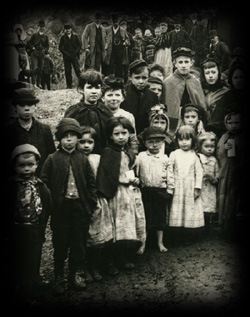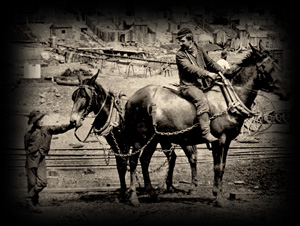 |
| Orphans and overseers of the Girard Trust, 1891 |
The family was the bedrock of the Pennsylvania coal region during the nineteenth century. With a high rate of occupational injuries, disease, and mortality, the uncertainties of the coal mining life created hardships not only for the miners themselves, but for those who depended on them for survival. Disabled and unemployed miners had few other options to support themselves in the coal region, and their survival often depended upon the support from the extended family. In case of hardship, a network of kin might be mobilized to provide assistance, serving as the "primary social safety net" for the working class. For most, family was the only safety net at all. Outside the family, opportunities for relief were few and often unpalatable, provided by a handful of charitable organizations like the Girard Trust (which cared for orphans or children who had lost their fathers), or by that bleak alternative, the poorhouse.
The very settlement of the coal region was shaped by the family. Whole families emigrated together from Europe and settled together, sharing towns, neighborhoods, and homes. Regardless of class or ethnic origin, the bilateral extended family remained the primary means of protecting economic well being long after emigration. For the working class and poor, family provided security and assistance in case of injury, illness, or loss of employment, but for the better off, too, family was central. For the well to do, family connections provided a means to help capitalize and promote business ventures, and to buffer against the vicissitudes of the market.
Unlike mining towns in the western United States, which were populated largely by single men living in boardinghouses, few residents in the antebellum anthracite region lived alone, though the precise definition of family was never firmly fixed. Federal census records for Saint Clair indicate that many households contained at least one additional resident beyond the nuclear family, in some cases clearly a relative, but in others, equally clearly not.
 |
| Mule train and drivers |
In Saint Clair, the family might include not only the nuclear core of husband, wife, and children, but aunts and uncles, cousins, or more distant kin, and in many cases, persons with no genetic relationship at all. Most often, these "extra" residents shared the homeowner's ethnicity and language, and were likely to have been either the providers or beneficiaries of financial assistance or personal services. Thus the Welsh immigrant, Thomas Phillips, rescued his fellow countryman Daniel Williams, a "relative," after Williams' store failed by purchasing the stock at sheriff's sale and transferring it to Williams' son, Christopher. Such patterns held true equally among Irish, German, English, Scottish, and Welsh families.
To overcome the difficulty of gleaning information about extended families from federal census records, which list information only by household, Anthony Wallace extracted data from a variety of sources including letters, diaries, church records, company books, and newspapers and compiled them into an alphabetical card file, which is included in his papers at the American Philosophical Society. As with the file recording injured and killed miners, the kinship file is a valuable resource for historians of Saint Clair and the Pennsylvania coal region.





